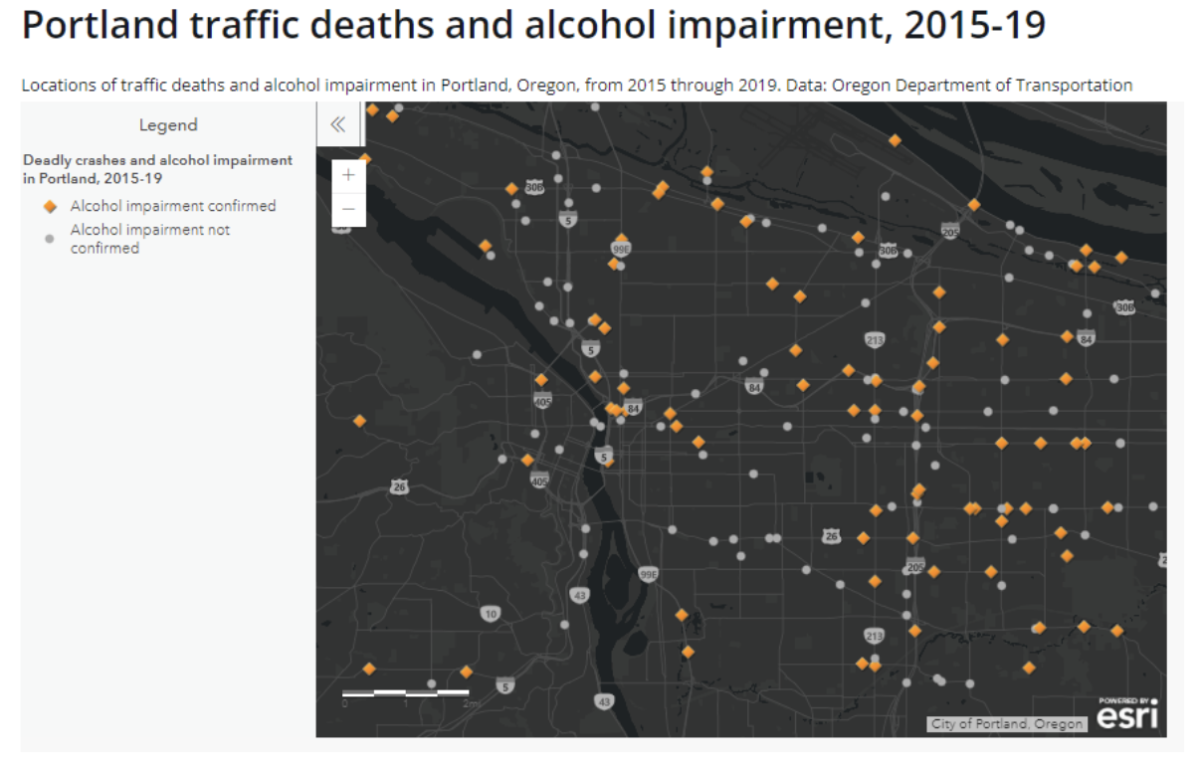
Everybody knows not to drink and drive. So why are we still seeing so many needless deaths from traffic crashes caused by people driving drunk?
As we’ve reported, traffic crash fatalities were very high in 2021, sharply increasing from the year before and leading our city far from its Vision Zero goal to eliminate traffic deaths. The Portland Bureau of Transportation released a statement Friday saying many of these deaths likely involved alcohol.
According to the Portland Police Bureau, at least 43 people in Portland died in 2020 and 2021 from crashes involving alcohol. Already this year, 34-year-old Salvador Manuel Rodriguez-Lopez was killed in a head-on collision with someone who was allegedly driving drunk on I-5 in Portland.
It’s not just Portland, either. Drunk driving fatalities appear to have gone up across the country since the pandemic.
Portlanders enjoy an abundance of craft breweries and wine tasting rooms, many of which have large parking lots – after all, it’s okay to have one drink and still drive, right? Well, no, not really.
“Even one drink can make it harder for people to visually track moving targets and to perform two tasks at the same time, both of which are important for driving. By the time a person hits Oregon’s legal blood alcohol content (BAC) limit they are three times more likely to crash compared to a sober person,” PBOT says.
In much of the United States, the BAC limit is 0.08 – a figure that’s hard to translate into number of drinks, because that can vary widely depending on factors like one’s size and liver condition. When Utah lowered its BAC limit to 0.05 in 2019, traffic deaths were reduced there. Oregonians voted against making our state the second in the nation to enact this lowered BAC limit, which advocates attributed to the powerful influence of the liquor industry.
But Vision Zero activists ask if more intense legal scrutiny is really the best practice here.
Advertisement
PBOT says they follow a “Safe System” approach, which they define as, “designing streets to protect people even when they make mistakes.”
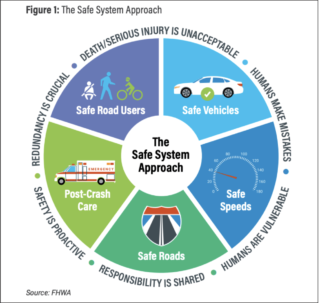
A “Safe System” approach to drunk driving crashes would take car and road engineering and design into consideration with as much weight as legal BAC restrictions and what punishments people who break the law should have to face.
On top of the American criminal justice’s system’s racial bias that enables cops to pull over and threaten people of color at disproportionate rates, focusing only on punishment puts all the individual responsibility on the person driving instead of acknowledging the structures at play here.
A Streetsblog article from December goes into detail about why an approach like this could be more racially equitable and actually save more lives:
Especially in the wake of the killings of Michael Brown and George Floyd by police officers, many proponents of Vision Zero have challenged U.S. transportation leaders to radically rethink the role of enforcement in their safety strategies, in recognition of the safety threat that cops themselves can pose to BIPOC road users. The specific vision for those reforms, though, varies from advocate to advocate, from the removal of armed police from all traffic stops, to the removal of armed police, to the removal of all human-based enforcement strategies in favor of automated cameras and “self-enforcing” road designs, and a universe of other possibilities in between.
Of course, there certainly needs to be personal responsibility when it comes to drinking and driving. In its blog post on the subject, PBOT suggests people take public transit, call a taxi or have a designated driver when drinking, and reminds us that it’s cheaper to pay for a parking ticket from leaving your car outside a bar than it is to get into a drunk driving crash.
But activists say we need to acknowledge our system is designed for this. We live in a culture dominated by both cars and booze, two things that go very poorly together. Without changing something at a bigger scale, telling people not to drink and drive can only go so far.



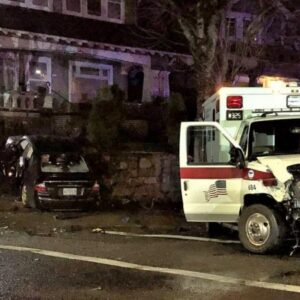
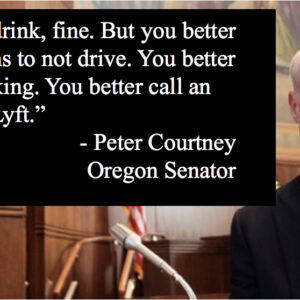
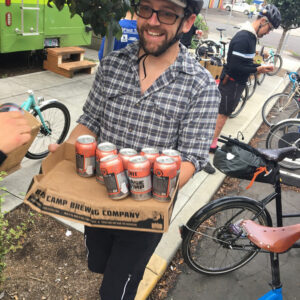
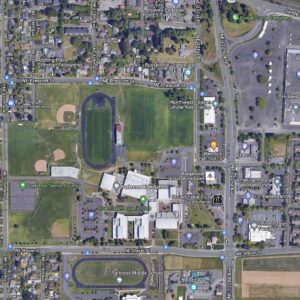
Thanks for reading.
BikePortland has served this community with independent community journalism since 2005. We rely on subscriptions from readers like you to survive. Your financial support is vital in keeping this valuable resource alive and well.
Please subscribe today to strengthen and expand our work.
Contract out with the Saudi justice system to try all DUI cases. They know how to treat ’em.
Having a conversation with someone not present — i.e., using a cell phone — while driving is also dangerously distracting, for largely the same reasons. (No, chatting with a passenger is not the same thing; no, things like eating are not equally distracting; and no, going hands-free isn’t better.)
I wish we could all acknowledge this, finally, and make phone use while driving as stigmatized as drunken driving. The fact that so many people use their phones while operating huge, powerful vehicles just boggles my mind.
I see plenty of people typing on their phones, looking down for many seconds while they do, and drive at the same time.
I guess I’m just too old as I’ve NEVER EVER had anything that required my immediate attention while driving, well, except for driving. Phone calls can go to voice mail, and a text message will still be there when I stop.
Hmmm, what would you rather happen?
A drunk driver caught on camera blowing through a red light and t-boning another car killing someone? -OR-
A police officer seeing the drunk driver, pulling them over and arresting them?
I know that police officers aren’t always the best solution in every situation, but there’s just some that they make sense that they are the point person.
Of course, outfitting all vehicles with alcohol and drug testers that don’t allow someone to drive with either in their system would be ideal. But I just don’t see that happening in my lifetime.
Oh, and Vision Zero . . . other than a few lawn signs what did PBOT really do??
Vision Zero–I really, really like the left-turn calming noses at intersections.
I like them too, but I don’t know if they are a meaningful step towards the goals of vision zero, which has, to date, had no real impact that I can see.
I think the best thing Vision Zero has done is that it’s provided a precise collection and visualization of data for advocates, politicians, and other citizens to use. With it, folks can access this data when asked to quantify needs for infrastructure improvements. Just as we are doing now. However its unfortunate that its now on folks like us to comb through this data and use it to justify asks like smarter, more resilient, and safer streets that should have been there generations ago.
Watts, without a control arm you can’t know how much worse off we might be without Vision Zero. Regarding the left-turn noses, there was a big study of them, out of DC I think, that showed they are effective. It is often not possible to get the statistical power you need to make definitive statements about a treatment working or not with a local implementation, so it’s easy, but not fair, to criticize that one doesn’t see a difference.
All I know is that PBOT wasted a once-in-15-years chance to fix cycling on North Denver by bending to the majority of homeowners on the route who preferred putting cyclists next to traffic rather than parked cars by reversing a decision to create a semi-protected bike lane. Upon the slightest blowback (my precious free parking!) they threw cyclists under the literal SUV.
…a drunk driver caught on camera blowing through a red light and t-boning another car…
Drunk drivers, or sober drivers who make a lot of bad choices, are much less likely to go through a red light because more risk averse drivers avoid crossing a yellow light because they don’t want a camera ticket. The T-bone never happens, at worst it becomes a rear end collision at lower closing speed which is a much smaller hazard.
If marginal driving is normalized as it is in 2022 that enables a lot of dangerous driving. Civil driving makes jackassery a lot more difficult. Your T-bone photo scenario is a straw man.
The Liquor Industry influences legislation on road safety? How could that ever happen?
I hope that one day every grade school in the state receives huge loads of posters, flyers, banners and such declaring “Be Safe, Be Seen” or “Bike Safe, Walk Safe”. And I mean huge loads.
In Portland, this answer is obvious. NO ENFORCEMENT.
Recidivism is extremely high with drunk driving. The DA could reduce the chances of the 2nd, 3rd, 4th, 5th… drunk driving collision by offering deals for first or more time offenders to trade reduced charges, reduced fines and no jail time in return for a lifelong drivers license revocation with no possibility of renewal in the state of Oregon, together with a permanent lifelong ban on registering a vehicle in the state of Oregon, and an immediate revocation of any existing Oregon vehicle registrations, with a red flag setup at DMV. If the person wants to drive again, they always have the option to move to another state. This approach would prioritize saving lives vs just punishment, which has shown to be extremely ineffective for this particular offense.
I wonder how many drinkers would take that deal, especially if they aren’t facing jail time yet, or just facing a short sentence.
From a 30,000 foot elevation there does “seem” to be a more heavily confirmed DUI crash incidence east of 82nd Ave…vs to the west…not sure if this is infrastructure / land use or frequency of OLCC permits / size of establishment (often with off street parking).
In that part of town the street and neighborhood layout means that to go far you have to use the ‘stroads’ and regardless of posted speed limit their construction gives drivers the notion that fast driving is ok.
Even for sober drivers wide streets, wide lanes and rippling greens invite speed. Speed kills. Ok, sudden stopping kills.
It’s common to see MV operators turn onto any major street and accelerate to a speed above the legal limit to catch a chain of green lights until they run up to the traffic behind a red. Yes, bike riders would do it if they could.
The system isn’t particularly safe for sober people trying to make a light instead of looking at the whole picture for pedestrians, etc. It’s much worse for people under the influence who are going to drive in a similar manner but with less attention, less self awareness, poor motor control, slower reactions…drunk.
The linked OPB article doesn’t tell us *anything* about racial bias. It’s like all lefty “science”- use an obfuscating and overly-complex data model with all kind of assumptions baked in, rule out any “unapproved” explanations as socially unacceptable thought, then relentlessly badger and bore everyone into “admitting” that up is down and cats are really dogs!
Serious question, maybe don’t issue parking tickets on Saturday and Sunday near bars and restaurants until after 11:30 am? I got a hefty ticket in downtown Seattle once after getting a ride home. I was back to get my vehicle very early too, like 9:30am.
Per the PBOT release: “Overnight parking is allowed at most public SmartPark garages and on many Portland streets. A parking ticket is also much cheaper than a crash.”
But yes, making sure underused parking isn’t enforced might be a valuable step. Currently good for Sunday, might want to re-study Saturday morning.
“Downtown parking meters operate from 8 a.m. to 7 p.m. Monday through Saturday, and from 1 p.m. to 7 p.m. on Sunday, unless otherwise posted.”
An overnight parking garage is probably cheaper than the ticket. My reasoning the tickets are appropriate is because downtown anywhere is not just for people to park their cars until their hangover subsides to a manageable level. There are other people who may want to park before the “very early” time of 9:30am.
I mean, can 9:30am be considered “very early”? The sun has been up for 3+ hours at that point, even this time of year.
When I didn’t bike, in the 1990s, the area of Seattle I’m talking about was nearly 100% bars, nobody needed that parking at 8:00 am, and getting back to that area in the morning was quite the mission. Yes, 9:30 is incredibly late in the day for me now, but to a person that had too much to drink and doesn’t ride a bike, not so much. I’m just throwing out ideas in an effort to get to less than 106 deaths a day from automotive collisions, like we had in 2021. Preventing drunk driving seems to be a better solution than bisting people for leaving their car parked in front of a bar until 11:30.
I suspect that if people knew they would very likely get arrested if they drove home drunk, they’d make alternative arrangements. Free parking is nice and all, but I don’t think it would provide sufficient motivation for people to do the right thing.
Why discriminate against day drinkers? We probably need free parking all day.
“On top of the American criminal justice’s system’s racial bias that enables cops to pull over and threaten people of color at disproportionate rates, focusing only on punishment puts all the individual responsibility on the person driving instead of acknowledging the structures at play here.”
Gold medal in Olympic level mental gymnastics for adopting this viewpoint.
Is there evidence that Portland police pull over people of color for DUII disproportionately to their rate of driving under the influence? If there is, I haven’t seen it. Given that Portland’s traffic division (back when we enforced traffic laws) did not disproportionately target racial/ethnic minorities, I think the default assumption has to be no.
And yes, responsibility for drunk driving rightfully falls pretty heavily on the drunk driver.
[Note to PS: I fully realize you do not disagree with me on this matter.]
Suggest you read the STOP reports.
They’re the Statistical Transparency of Policing reports required by the Oregon Legislature. I haven’t reviewed the recent Portland one, but ones in Salem show disproportionate enforcement.
I looked at those documents briefly, they are complicated, and I’m not sure what you wanted to point out. PPB publishes statistics about who their traffic division stops, and I am only characterizing the data I have reviewed.
It is important to remember that the correct metric to compare with to gauge bias is the underlying rate of violation. For example, if young males make up 20% of the population, but commit 50% of the speeding, you’d expect 50% of the speeding tickets to be issued to young males. You can’t claim bias if young males get 30% of the tickets on the basis that 30% is more than 20%.
PPB statistics address this point in their reports, using crash rates as a surrogate metric for the rate of traffic violations.
Do you think that government decisions impact:
1. How much people have to drive?
2. How good the options are for people to get around without driving?
3. How safe it feels to exceed the speed limits?
4. Where police choose to enforce laws?
5. What speeds cars are designed to go at?
6. How available alcohol is, and to what ages?
7. How much housing costs, impacting where people live and where they travel?
If yes to any of the above, was that Olympic-level thinking on your part?
Keeping in mind this article was about consuming alcohol and operating motor vehicles, no, I keep the onus on the individual/driver/operator, not the government. Because:
1.) Nobody HAS to drive to consume alcohol, that is an individual choice and should have massive consequences for doing so without concern for the rest of the general public who does not but is forced to share the road with someone who does.
2.) The general public is under no obligation to provide public transit for people to consume alcohol more easily or at all.
3.) Again, the speed limits are known by all operators of vehicles, to violate those sober or intoxicated should be met with consequences from enforcing those laws.
4.) Police tend to enforce the laws where there is crime, regardless, the enforcement of finding drunk drivers could reduce lives lost by a meaningful number (especially with a lens from the Hardesty School of Statistical Analysis), much more than concern about racial bias in policing.
5.) Cars can go slow just as easy as they can go fast, what they need is an operator that cares about the consequences of going the speed appropriate for the environment.
6.) Yes, it is available to 21 and older, and those individuals need to know that it is important to consume alcohol safely and be afraid of the consequences of not doing so.
7.) Again, same as 1, nobody is forcing anyone to have to travel from their home to consume alcohol and then drive back home.
What is impressive to me is that you believe the government should be responsible for just about every single possible interaction with alcohol but for the actual enforcement of the laws we already have on the books. Somehow, everyone else in the public should bear the cost of making the roads safe for people who don’t care about anyone else or themselves in the slightest, when we could just throw the book at them and things might turn around.
Do these factors in any way excuse people who decide to drive drunk?
0.05% is still too high.
https://www.government.se/government-of-sweden/ministry-for-foreign-affairs/diplomatic-portal/diplomatic-guide/9.-respect-for-the-local-laws-and-regulations/9.1-drunk-driving/
Mandatory safety infrastructure would be far more effective than toothless law changes. Ignition interlocks should be mandatory for every SUV-truck/pickup-truck/(car). A few seconds of your time is worth preventing the tens of thousands of serious injuries and deaths associated with alcohol use.
I don’t really see more policing as an answer to this problem. It seems like there are 2 tacts that the US has taken in regards to drunk driving and they are: policing (with ALL it’s inherent problems, the biggest one being, that it doesn’t actually seem to do much in the long run to reduce drunk driving, or distracted driving, or speeding, or anything else) and Public Service campaigns in the vein of billboards and radio spots.
However, the “Safe System” approach is not working, and in order to work would involve such a massive overhaul of all of our infrastructure that I don’t think we could afford it. Sure, PBOT should keep taking those strategies into account as infrastructure gets updated, but what about for now.
What about more massive campaigns to get people out of their cars if they’re drinking in the first place? Free transit, more expensive parking options in nightlife areas, campaign inside the bars to remind people that they should leave their cars at home if they’re going out drinking, like, GO BIG. Like with everything else in driving, everyone seems to think it’s only “other people” causing the problem.
And we should figure out how to get the booze out of lobbying locally, because this isn’t the only time they’ve lobbied to the detriment of our community.
An ignition interlock system does not require policing.
Sure…until folks learn how easy it is to bypass said system.
What then — enforce the law or allow drunk driving?
Nonsense. Modern interlock systems have cameras and, contrary to interwebs mythology, do not respond to pressurized air.
One can uninstall the system altogether with YouTube, a screwdriver, and two wire nuts.
So who is going to ensure an interlock system is installed in every auto in the country. And someone needs to ensure there calibrated and working properly.
Airbags and ABS are far more complex than interlock systems.
Yes but interlocks systems have to be calibrated every 30 to 180 days depending on state requirements. In Oregon its 30 or 90 days dependent on who manufactured the device. Also I was under the impression that you wanted them installed in all vehicles. ABS and Airbags are not in all autos. Airbags were required Sept 1 1998 and ABS Sept 1 2012. So all you have to do is lobby the NHTSA and who knows in 5 to 10 years they could be required on all new vehicles. It seems like a simple solution but it rarely is.
It’s more like a year or two in societies that make far greater use of interlock systems (e.g. much of central and northern europe). Calibration would, of course, be part of annual or semiannual vehicle maintenance. This is hardly an insurmountable barrier to widespread adoption.
Are you actually arguing that Airbags and ABS should not be installed in every automobile?
I didn’t realize interlocks were so much more prevalent in Europe. Very interesting and refreshing to see some countries put common sense limits on driver behavior.
https://etsc.eu/spain-major-changes-to-road-safety-rules-will-see-alcohol-interlocks-in-new-passenger-transport-vehicles-and-mandatory-helmets-for-e-scooter-riders/
I know you are speaking to the technical aspect of these systems. But I don’t believe it is even illegal to drive with the ABS or Airbag disabled. I don’t even think you would fail the bi-annual DEQ inspection. We have a very strong culture of tampering (modding or tuning) our cars in the US. We need to go back to basics and have stricter inspections and road-worthiness guidelines. That alone would remove so many dangerous vehicles and drivers from our roads.
100% agree we could add interlocks to all cars. But I have very little faith that will happen given the “car = freedom” ideology.
Fortunately, there has been some progress when it comes to airbag requirements:
https://firstquarterfinance.com/is-it-illegal-to-drive-without-airbags/
No I was not saying cars should not have ABS or Airbags. I was pointing out the fact that safety systems for autos are installed after the NHTSA approves the inclusion of such systems for NEW autos. Then it still may take several years before manufactures can comply. Even in the EU Interlocks are only required after someone has been convicted of drunk driving. The difference that takes effect this year is that it only requires 1 conviction. That is something that should be done here in the US as well. We know that state(s) do a poor job following up on drivers with suspended license, how well do they supervise drivers with required interlocks. So if police should not exist in your world who is in charge of compliance?
Yeah, sorry for the direct reply. I … think I started saying something about the interlock system, but got sidetracked mentally and then started thinking about other things.
Unfortunately, as much as this probably SHOULD be the way it’s solved. USians see “freedom” = right to put people at risk, regardless, so any infringement on their cars or alcohol consumption seems like such an uphill battle. 🙁
So many easy, cheap, compassionate, and respectful behaviors are seen as impossible in this Kafkaesque culture.
And, Eli, thanks for using the word “USians” here. Apparently some commentators believe I’m the only human being in existence that is offended by the colloquial use of “american” to describe a resident of the USA.
And just in case anyone has any questions about my stance on this issue: I support and have always supported abolishing the police.
Well, I have questions now.
Is it your view that laws are unnecessary? Or that society has evolved beyond the need to enforce them?
The primary role of the police is to protect predatory rentiers. They have little to do with public safety, according to my opinion.
A .02 BAC equates to one customarily sized drink in the USA, not the two asserted in this Swedish chart. I’m mentioning that here so folks don’t falsely conclude that having two standard USA pours would keep them at a .02 — because per the NHTSA, that would actually put a 160-lb man at a .05.
A real pint of higher gravity craft beer, say 6.5% ABV, is basically two beers. That’s a very normal thing to be served in Portland.
Ok, I did the arithmetic, 16 oz of 7.5% ABV is exactly double 12 oz of 5.0% ABV. Sometimes I drink high gravity beers but more than one gives me a drunk feeling that I don’t really like. There’s no serious probability of getting a DUII, especially on a bike so enforcement is not my deterrent. Actually my greatest influence is the witness of friends who have lost loved ones to drinking drivers.
When you’re out, asking for lower gravity beers sends a message to the industry. It’s a quiet way to save lives.
I was out after work with my co-workers over in close in E. Portland (east of Sellwood). I had ridden to work that day then put my bike in the back of one of the guys cars to get to the pub. I had *one* craft beer and when I walked out I suddenly realized that I *really* didn’t want to ride in an unfamiliar area feeling a bit buzzed and tossed my bike on a bus rack to get downtown to the MAX.
I didn’t want to ride buzzed for the same reason I don’t use headphones while riding – I need all my capabilities to stay safe out there.
Oregon has an anything over .00 BAC standard – for underage drivers.
Like many eastern europeans, I often drink a glass of wine with my evening meal. However, I would definitely support the 0.00 BAC standard for everyone. If you want to use alcohol, plan to do so at home or use other means of transportation to get home.